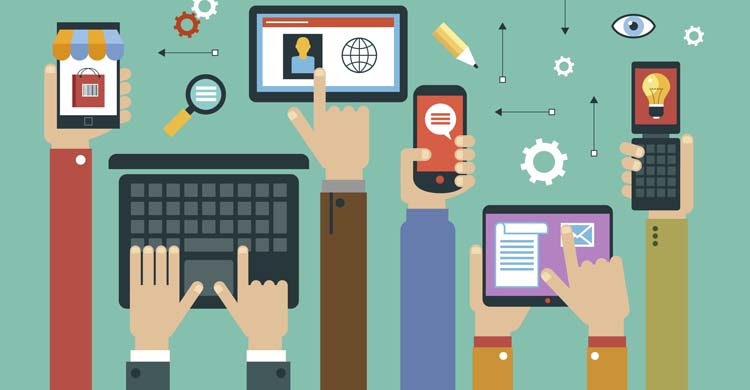
The COVID-19 has accelerated the growth of these 7 key tech trends which include Online Shopping, Digital and Contactless payments, Remote Work, and more. With the help of these technologies the spread of the coronavirus has decreased and has helped the business to stay open. We believe that technology can help us be more resilient in times of pandemic and other threats.

These technologies have helped us in being functional during the lockdown and quarantine period, they have a long-lasting impact beyond the pandemic. Here are a few tech trends which are thriving and help us during the COVID-19 pandemic.
7 Tech Trends that are Thriving During the COVID-19 Pandemic
1. Online Shopping and Robot Deliveries
The Coronavirus has always compelled us to stay at home and maintain distance from people. Due to these restrictions, it has become difficult for people to buy their necessities and to move out of their house. So, it is crucial to have a good Online Shopping system.

Also Read: Smart Assistants: Google vs Alexa vs Siri [Infographics]
Online shopping is without a doubt, the most important tech trend. This must be supported by a robust logistics system. We can’t guarantee that In-person delivery is virus-proof. This is the reason many delivery companies and restaurants in the US and China are incorporating contactless delivery services.
They pick up the goods and drop them off at a designated location instead of taking or giving it in the hands of a person. The Chinese e-commerce giants are also thriving up by adding robot deliveries. But the companies need to take proper protocols to incorporate the sanitary condition of the goods, even before robot delivery services become prevalent.
2. Digital and Contactless Payments
The next tech trend we are going to discuss is the Digital and contactless payments. Even Cash is not virus-proof, it can also carry the virus around. So, the central banks in countries like China, the US and South Korea have taken various measures to make sure that the banknotes are safe to use before they go into circulation.

Also Read: Top 4 Best UPI Apps for Reliable Money Transfer
People are encouraged to use contact with fewer digital payments now. It can be either in the form of e-wallets or cards. This could help in avoiding the spread of the virus. Through this, people can receive stimulus funds faster and use digital payments to make online purchases and payments of goods, services, and even utility payments.
But, according to the World Bank, there are around 1.7 billion people with no bank account, so it is not easy for them to access digital payments. Not only that, but this method of payment relies on internet availability, devices, and a network to convert cash into a digitalized format.
3. Remote Work
Many organizations have asked employees to work from home. Remote work is empowered by technologies including virtual private networks (VPNs), voice over internet protocols (VoIP), virtual gatherings, cloud innovation, work coordination tools, and even facial recognition advances that empower an individual to show up before a virtual background to protect the security of the home. And, is stopping the spread of infections, remote work additionally spares drive time and gives more flexibility.

Also Read: Top 5 Best Zoom Alternatives for Video Calling
Yet remote work likewise forces challenges to managers and representatives. Data security, protection and convenient technical support can be enormous issues, as uncovered by recent class activities documented against Zoom. Remote work can likewise convolute labor law issues, for example, those related to giving a safe workplace and income tax issues. Employees may encounter loneliness and absence of work-life balance. If remote work turns out to be more common after the COVID-19 pandemic, managers may choose to decrease rent costs and hire individuals from districts with less expensive work costs.
Laws and guidelines must be refreshed to suit remote work – and further psychological examinations should be led to comprehend the impact of remote work on people. The evolvement of this tech trend is necessary to keep the economy stable.
4. Distance Learning
As of mid-April, 191 countries declared school or college closures, affecting 1.57 billion students. Numerous instructive foundations began offering courses online to guarantee training was not disrupted by isolate measures. Innovations engaged with distant learning are like those for remote work and furthermore incorporate virtual reality, augmented reality, 3D printing and artificial-knowledge empowered robot teachers.

Also Read: Microsoft Family Safety App Preview Now Available for iOS and Android
Concerns about this tech trend are the possibilities that the innovation can make a wider divide in terms of digital availability and salary level. This tech trend could likewise make economic pressure on guardians – even more frequently ladies – who need to remain at home to watch their youngsters and may confront decreased efficiency at work.
5. Telehealth
Telehealth can be a compelling method to contain the spread of COVID-19 while as yet giving basic essential consideration. Wearable individual IoT gadgets can track vital signs. Chatbots can make starting analysis dependent on side effects identified by patients.

Also Read: Aarogya Setu App: All You Need to Know
In any case, in nations where clinical expenses are high, it’s critical to guarantee that this tech trend will be secured by protection. Telehealth likewise requires a specific degree of tech education to work, just as a decent internet connection. What’s more, as clinical administrations are one of the most vigorously managed organizations, specialists can just give clinical care to patients who live in the same authority. Guidelines, at the time they were composed, might not have imagined a reality where telehealth would be available.
6. 5G Communication
With the expanding interest for quicker and higher data transmission systems, because of remote working, 5G which is the next generation network planned with “Service Based” engineering may get adopted sooner. 5G gives more prominent nature of service dependent on the system ‘Slice’, which considers a specific assistance type, for example, IoT, Low latency applications and so forth.

Also Read: Effects of Artificial Intelligence: All you need to know
For instance, for a remote medical procedure use case, where low latency is a basic parameter, 5G can perform better than the current systems network solutions. Addressing these issues to make sure there is access to the internet will continue to be a challenge as this tech trend expands globally.
7. Online Entertainment
Although measures taken like maintaining social distancing have diminished face to face communications fundamentally, human innovativeness bought the party on the web. Cloud raves and web-based concerts have gained traction everywhere.

Also Read: Do We Need Antivirus in Our Daily Use?
Chinese film creation organizations likewise released movies on the web. Exhibitions, museums and International heritage sites offer virtual visits. There has likewise been a flood of online gaming traffic since the outbreak.
Importance of digital readiness and being a part of these tech trends
COVID-19 has exhibited the significance of digitalized availability, which permits business and life to proceed as usual during pandemics. Building the fundamental foundation to help a digitized world and remain current in the most recent tech trends will be basic for any business or nation to stay serious in a post-COVID-19 world, and also take a human-centered and comprehensive way to deal with innovation governance.
As the BBC brings up, an expected 200 million individuals will lose their positions due to COVID-19. Furthermore, the budgetary weight frequently falls on the most helpless in the public eye. Digitization and pandemics have quickened changes to employments available to people. The solution to these problems requires a timely and human-centered approach. It is important that we utilize these tech trends and make the most out of it.
Read more:
Directly in Your Inbox
- 3d printing
- coronavirus
- COVID-19
- Distance learning
- Online Shopping
- pandemic
- Robot
- Tech trends
- Technology
- work from home









